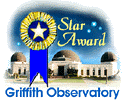Comet Observation Home Page
 This image of C/1995 O1 (Hale-Bopp) was taken by Chander Bhushan Devgun (New Delhi, India)
using 28 mm f/2.8 lens and 400 ASA film. The exposure was 1 min.
This image of C/1995 O1 (Hale-Bopp) was taken by Chander Bhushan Devgun (New Delhi, India)
using 28 mm f/2.8 lens and 400 ASA film. The exposure was 1 min.
 The Hubble Space Telescope images Comet Hale-Bopp on August 27,1997. Click on
this image to go to Hal Weaver's posting of images and explanation.
Dr. Weaver is the HST Principal Investigator for the Hale-Bopp observations.
The Hubble Space Telescope images Comet Hale-Bopp on August 27,1997. Click on
this image to go to Hal Weaver's posting of images and explanation.
Dr. Weaver is the HST Principal Investigator for the Hale-Bopp observations.
 Hale-Bopp will become visible once again for Northern Hemisphere observers
south of about +45 degrees for a month or so. You will need an excellent southeast
horizon to see the comet, which is likely to be magnitude 5 or 6.
This chart, which was provided by Dale Ireland, shows where the Comet Hale-Bopp
is in the sky at one hour before local sunrise for
observers at +35 degrees latitude.
(Click on
image for larger view.)
Hale-Bopp will become visible once again for Northern Hemisphere observers
south of about +45 degrees for a month or so. You will need an excellent southeast
horizon to see the comet, which is likely to be magnitude 5 or 6.
This chart, which was provided by Dale Ireland, shows where the Comet Hale-Bopp
is in the sky at one hour before local sunrise for
observers at +35 degrees latitude.
(Click on
image for larger view.)
Click here to see previous images


Last Updated: 26 September 1997
In this home page:
 Comets Currently
Visible (8/11/97)
Comets Currently
Visible (8/11/97)
 The Great Comet of 1997...
The Great Comet of 1997...
- Information on
Comet Hale-Bopp for the Non-Astronomer (9/9/97)
 Recent News and Observations (9/26/97)
Recent News and Observations (9/26/97)
 Comet Light Curves (5/9/97)
Comet Light Curves (5/9/97)
 Ephemerides for Current Visually Observable Comets (8/11/97)
Ephemerides for Current Visually Observable Comets (8/11/97)
 Comet Definitions
Comet Definitions
 Other Sources of Comet Information (2/2/96)
Other Sources of Comet Information (2/2/96)
 Comet Images (7/25/97)
Comet Images (7/25/97)
 Other Pages Featuring Comet Images
Other Pages Featuring Comet Images
 The People Who Discover Comets
The People Who Discover Comets

 NASA Home Page
NASA Home Page
 JPL Home Page
JPL Home Page

Awards
The biggest reward for doing this home page is the positive feedback that
I get and the knowledge that users find this page a useful service.



(Of course, I think it should have received four stars, but I am a bit biased.)

Statistics
Typically, about 1,000 individual users/computers access this page every day. These
accesses create more than 15,000 entries per day in the access log. This
amounts to an increase in the size of the access log of 1.5 Mbytes per day!
However, the peak access rate during the C/1995 O1 (Hale-Bopp) apparition
was >>30,000 users. The peak usage was more than 550,000 hits per day.

Comments? (Please include your
e-mail address. Often times your comments/questions require an individual response. I
can't provide that if I don't know how to contact you!!)
Charles S. Morris / csm@encke.jpl.nasa.gov





![]()
![]()
 Comet Images (7/25/97)
Comet Images (7/25/97)
![]()
![]()

![]()
![]()
![]()